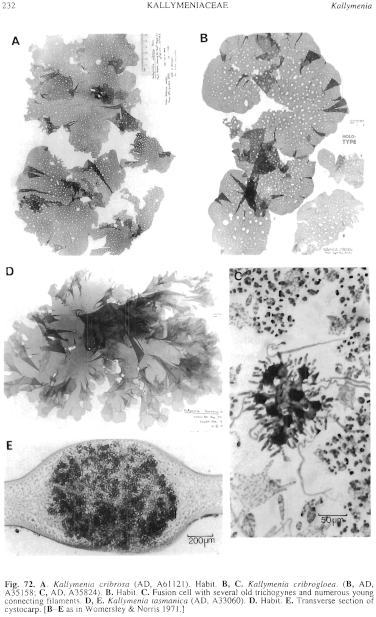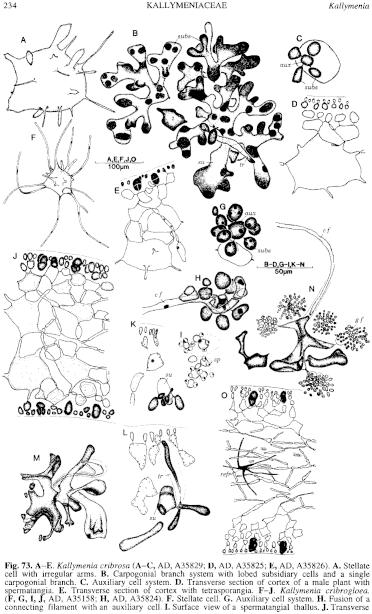|
|
|
|
|
|||||||||||
|
Electronic Flora of South Australia Species Fact Sheet
Phylum Rhodophyta – Class Florideophyceae – Order Gigartinales – Family Kallymeniaceae
Selected citations: J. Agardh 1876: 220,686. Lucas & Perrin 1947: 162, fig. 34. Womersley & Norris 1971: 12, figs 21–25,84, 85.
Synonym
Grateloupia australis J. Agardh ex Gepp & Gepp 1906: 260. De Toni 1924: 546.
Thallus (Fig. 72D) dark red, often paler above, foliose, arising from a slender stipe 0.2–1 cm long, 5–30 cm high and across, often with numerous large, marginal lobes which are often overlapping and themselves lobed; substance firm and tough, adhering to paper on drying. Holdfast discoid, 1–3 mm across; epilithic. Structure. Thallus 250–500 µm thick (Fig. 73 0), consisting of 3–4 layers of cortical cells and a medulla of fairly loosely arranged filaments 3–8 µm in diameter; outer cortical cells 5–10 µm across and isodiametric to elongate in surface view; medulla with darkly staining refractive cells (Fig. 73 0) with several long slender arms.
Reproduction: Sexual thalli probably dioecious. Carpogonial branch systems (Fig. 73K, L) monocarpogonial, the supporting cell bearing 2 elongate (terminally swollen but not lobed), subsidiary cells and a 3-celled carpogonial branch, the first and second cells of which become elongate. Fusion cell lobed (Fig. 73M) producing relatively few connecting filaments. Auxiliary cell systems very similar to carpogonial branch systems; following fusion with a connecting filament (Fig. 73N), the auxiliary cell elongates and develops lobes from which gonimoblast filaments are produced, with the subsidiary cells remaining virtually intact. Cystocarps (Fig. 72E) 0.5–1 mm in diameter, swollen, consisting of a dense mass of groups of carposporangia intermixed with filaments; carposporangia subspherical to ovoid, 12–18 µm in greatest dimension. Male thalli not observed.
Tetrasporangia scattered in the outer cortex (Fig. 73 0), ovoid, cruciately to irregularly divided, 18–35 µm long by 11–16 µm in diameter.
Type from Georgetown, Tas. (Alg. Aust. Exsicc. 418); lectotype in Herb. Harvey, TCD.
Selected specimens: Gulf St Vincent, S. Aust., 40 m deep (AD, A16142). Port Elliot, S. Aust., drift (Womersley, 24.vii.1949; AD, A11122). Crawfish Rock, Westernport Bay, Vic., 5–10 m deep (Watson, 10.xi.1968; AD, A33060), 4–5 m deep (Watson, 26.iv.1969; AD, A34270) and 10 m deep (Watson, 25.iv.1969; AD, A34362). Great Taylor Bay, Bruny I., Tas., 19 m deep (Shepherd, 14.ii.1972; AD, A42155).
Distribution: Gulf St Vincent, S. Aust., to Western Port, Vic., and around Tasmania. A sublittoral species ranging from just below low tide level to 10 m deep in Western Port.
Taxonomic notes: K. tasmanica, the second species of Kallymenia described from Australia, differs from other Australian species in its large, smooth, and often lobed thallus, of fairly tough consistency. It is also distinctly separated from other species by being monocarpogonial with simple, elongate subsidiary cells and by the absence of differentiated auxiliary cell systems (these being very similar to carpogonial branch systems). All other known species of Kallymenia have distinct auxiliary cell systems with small, subspherical subsidiary cells.
J. Agardh (1890a, p. 17) described a var. laciniata, without locality. The specimen concerned has not been studied, but K. tasmanica is variable in form and laciniate plants are not worth distinguishing as a variety. Comparison of the specimen should, however, be made with Thamnophyllis lace rata.
Grateloupia australis J. Agardh ex Gepp & Gepp (1906, p. 260) is K. tasmanica. The species was based on Wilson material in BM, from Port Phillip, Vic., and although not recognised by the Gepps, one specimen from Capel Sound, Port Phillip Bay (Wilson, 26.xii.1886) is sparsely cystocarpic.
References:
AGARDH, J.G. (1876). Species Genera et Ordines Algarum. Vol. 3, Part 1 - Epicrisis systematis Floridearum, pp. i-vii, 1–724. (Weigel: Leipzig.)
AGARDH, J.G. (1890a). Till algemes systematik. Acta Univ. lund. 26(3), 1–125, Plates 1–3.
DE TONI, G.B. (1924). Sylloge Algarum omnium hucusque Cognitarum. Vol. 6. Florideae. (Padua.)
GEPP, A. & GEPP, E.S. (1906). Some marine algae from New South Wales. J. Bot., Lond. 1906, 249–261, Plate 481.
HARVEY, W.H. (1860a). Algae. In Hooker, J.D., The Botany of the Antarctic Voyage. 111. Flora Tasmaniae. Vol. II, pp. 321–343, Plates 185–196.
HARVEY, W.H. (1863). Phycologia Australica. Vol. 5, Plates 241–300, synop., pp. i-lxxiii. (Reeve: London.)
LUCAS, A.H.S. & PERRIN, F. (1947). The Seaweeds of South Australia. Part 2. The Red Seaweeds. (Govt Printer: Adelaide.)
WOMERSLEY, H.B.S. & NORRIS, R.E. (1971). The morphology and taxonomy of Australian Kallymeniaceae (Rhodophyta). Aust. J. Bot. Suppl. 2, pp. 1–62.
The Marine Benthic Flora of Southern Australia Part IIIA complete list of references.
Publication:
Womersley, H.B.S. (14 January, 1994)
The Marine Benthic Flora of Southern Australia
Rhodophyta. Part IIIA, Bangiophyceae and Florideophyceae (to Gigartinales)
Reproduced with permission from The Marine Benthic Flora of Southern Australia Part IIIA 1994, by H.B.S. Womersley. Australian Biological Resources Study, Canberra. Copyright Commonwealth of Australia.
Illustrations in Womersley Part IIIA, 1994: FIGS 72D, E, 73K-0.

Figure 72 enlarge
Fig. 72. A. Kallymenia cribrosa (AD, A61121). Habit. B, C. Kallymenia cribrogloea. (B, AD, A35158; C, AD, A35824). B. Habit. C. Fusion cell with several old trichogynes and numerous young connecting filaments. D, E. Kallymenia tasmanica (AD, A33060). D. Habit. E. Transverse section of cystocarp. [B–E as in Womersley & Norris 1971.]

Figure 73 enlarge
Fig. 73. A–E. Kallymenia cribrosa (A–C, AD, A35829; D, All, A35825; E, AD, A35826). A. Stellate cell with irregular arms. B. Carpogonial branch system with lobed subsidiary cells and a single carpogonial branch. C. Auxiliary cell system. D. Transverse section of cortex of a male plant with spermatangia. E. Transverse section of cortex with tetrasporangia. F–J. Kallymenia cribrogloea. (F, G, I, J, AD, A35158; H, AD, A35824). F. Stellate cell. G. Auxiliary cell system. H. Fusion of a connecting filament with an auxiliary cell. I. Surface view of a spermatangial thallus. J. Transverse section of a tetrasporangial thallus. K–O. Kallymenia tasmanica (K, L, AD, A33060; M, N, AD, A34362; O, AD, A34270). K. Young carpogonial branch. L. Mature carpogonial branch. M. Fusion cell with old trichogyne and young connecting filaments. N. Auxiliary cell system with fused connecting filament and developing gonimoblasts. O. Transverse section of tetrasporangial thallus. [A-0 after Womersley & Norris 1971.]

|
Email Contact: State Herbarium of South Australia |

|